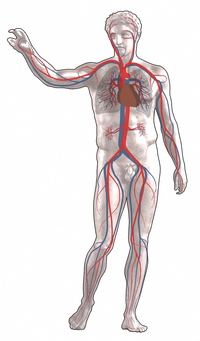
Photo from wikipedia
Introduction: The partial oxygen pressure in the air decreases with increasing altitude. This study was designed to compare the pulse oxygen saturation (SpO2) among well full-term neonates at different altitudes… Click to show full abstract
Introduction: The partial oxygen pressure in the air decreases with increasing altitude. This study was designed to compare the pulse oxygen saturation (SpO2) among well full-term neonates at different altitudes during their first 2 h after birth and to establish cutoff values of SpO2 identifying hypoxemia between 30 and 120 min after birth. Methods: A multisite prospective cohort study was conducted at five participating hospitals from the Chinese High Altitude Neonatal Medicine Alliance. Healthy full-term infants were recruited and divided into four groups based on the altitude. Preductal SpO2 was recorded at 10 min, 10–30 min, and 30–120 min after birth. The 2.5th percentile of the SpO2 distribution range was considered as the cutoff for identifying hypoxemia at each altitude. Results: A total of 727 infants were eligible for analysis. The SpO2 of neonates at different altitudes increased with the time after birth. A higher altitude was associated with lower SpO2, especially Shangri-La (3,509 m) and Yushu (4,360 m). The cutoff SpO2 for identifying hypoxemia during 30–120 min after birth were 94% in Xishuangbanna (847 m), 92% in Kunming (1,983 m), 89% in Shangri-La (3,509 m), and 83% in Yushu (4,360 m). Conclusion: An increase in altitude, especially Shangri-La (3,509 m) and Yushu (4,360 m), had a significant impact on SpO2 among healthy full-term neonates during their first 2 h of life. Establishing the cutoff value of SpO2 for identifying hypoxemia during the early postnatal period serves to optimize the oxygen therapy at different altitudes.
Journal Title: Neonatology
Year Published: 2022
Link to full text (if available)
Share on Social Media: Sign Up to like & get
recommendations!